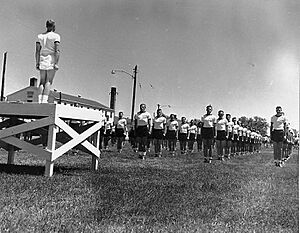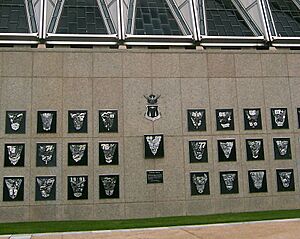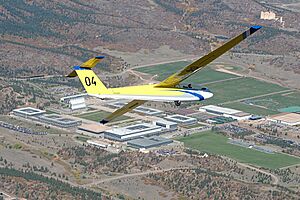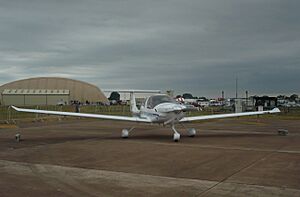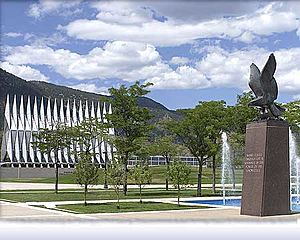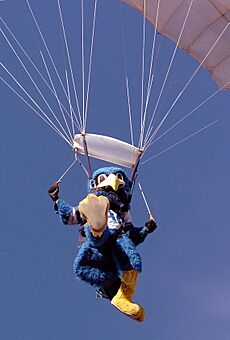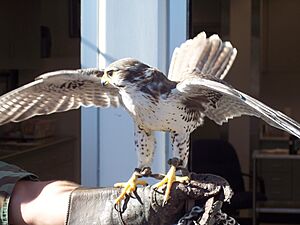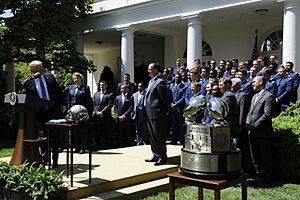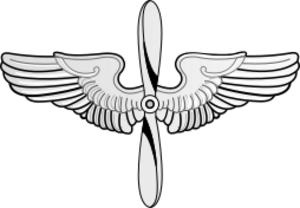United States Air Force Academy facts for kids
 |
|
| Motto | Integrity First, Service before self, Excellence in all we do |
|---|---|
| Type | U.S. Service Academy |
| Established | April 1, 1954 |
| Endowment | $98.937 million (2019) |
| Superintendent | Lieutenant General Tony D. Bauernfeind, USAF |
| Dean | Brigadier General Linell Letendre, USAF |
| Commandant of Cadets | Brigadier General Gavin Marks, USAF |
|
Academic staff
|
570 (71% military; 29% civilian in 2013) |
| Students | 4,304 cadets (2021) |
| Location |
Air Force Academy
,
,
U.S.
38°59′55″N 104°51′15″W / 38.9985°N 104.8541°W |
| Campus | Suburban, 18,500 acres (7,500 ha) |
| Colors | Blue Gray |
| Nickname | Falcons |
|
Sporting affiliations
|
NCAA Division I FBS – MW MPSF, Big 12, ASUN, PRC, WCC, AHA |
| Mascot | Air Force Falcons |
| Decorations | Air Force Outstanding Unit Award Air Force Organizational Excellence Award |
| Athletics | 27 varsity teams 17 men's and 10 women's |
| Website | (Military) (Educational) |
 |
|
The United States Air Force Academy (USAFA) is a special school for future military officers. It is located in Air Force Academy, Colorado, just north of Colorado Springs. This academy trains young people, called cadets, to become officers in the United States Air Force and the United States Space Force.
It is the newest of the five U.S. military academies. The first class of cadets graduated in 1959. After four years at the academy, graduates earn a Bachelor of Science degree. They then become second lieutenants in the Air Force or Space Force. The academy is also a popular place for tourists to visit in Colorado. About a million people visit it every year.
Getting into the academy is very competitive. Each year, about 1,200 cadets join the incoming classes. Since 2012, about 20% of these cadets do not graduate. While at the academy, cadets receive free tuition, housing, food, and a monthly payment. By their second year, cadets promise to serve as officers in the Air Force or Space Force. If they leave after this point, they might have to serve as enlisted members or pay back their tuition. This service commitment is usually five years of active duty.
Contents
History of the Academy
How the Academy Started
People who supported air power wanted a separate Air Force Academy for a long time. They thought it would be like the U.S. Military Academy (West Point) and the Naval Academy (Annapolis). In 1918, Lieutenant Colonel A.J. Hanlon said an "Aeronautical Academy" was needed. He believed it would teach future officers important values like love of country and honor.
In 1919, a law was proposed to create an academy. But it failed because of worries about cost and where it would be. General Billy Mitchell, an air power pioneer, also argued for an air academy in 1925. He said it would be the "backbone" of the air service, just like West Point and Annapolis were for the Army and Navy. However, his ideas did not get enough support at that time.
After World War II, the National Security Act of 1947 created a separate Air Force. This made the idea of an Air Force Academy more popular. In 1950, a special board led by Dwight D. Eisenhower said that a new academy was needed. The existing academies could not meet the Air Force's needs.
So, in 1954, Congress passed a law to build the Air Force Academy. President Eisenhower signed it on April 1, 1954. A group of advisors, including Charles Lindbergh, helped choose the location. They looked at 582 places and narrowed it down to three. The final choice was Colorado Springs, Colorado. The Air Force Secretary, Harold E. Talbott, announced this decision on June 24, 1954.
From 1954 to 1956, land was bought for the new academy. The largest piece was the 4,630-acre Cathedral Rock Ranch. In total, 140 pieces of land were bought. This created the nearly 18,500-acre property we see today.
The Early Years
The academy's main campus was not ready when the first class started. So, 306 cadets from the Class of 1959 began their training at Lowry Air Force Base in Denver. They were sworn in on July 11, 1955. They lived in old World War II buildings. There were no older cadets to train them. So, the Air Force brought in "Air Training Officers" (ATOs). These were young officers, many from West Point or Annapolis. They acted like older cadets until more classes joined.
The academy's dedication ceremony was on that first day. It was shown live on national television. Famous reporter Walter Cronkite covered the event. Film director Cecil B. DeMille designed the cadet parade uniform. This uniform is still used today.
The Class of 1959 started many important traditions. They created the Cadet Honor Code. They also chose the falcon as the academy's mascot. On August 29, 1958, the 1,145 cadets moved to the current site near Colorado Springs. Less than a year later, the academy became officially recognized. The first USAFA class graduated on June 3, 1959.
The Vietnam War Era
The Vietnam War was the first war where academy graduates fought and died. This war greatly shaped the academy. More pilots were needed, so the number of cadets grew a lot. Graduating classes went from 217 cadets in 1961 to 745 in 1970.
The academy expanded its facilities and changed its training. The Jacks Valley field training area was added. The Survival, Evasion, Resistance and Escape (SERE) program was made bigger. Light aircraft training began in 1968.
Many graduates from this time served bravely. Pilots like Steve Ritchie and Jeffrey Feinstein became "aces" by shooting down five enemy planes. 141 graduates died in the war. 32 became prisoners of war. Lance Sijan, a graduate from 1965, was awarded the Medal of Honor. This was for his bravery while avoiding capture and as a prisoner. Sijan Hall, a cadet dormitory, is named after him.
Women Join the Academy
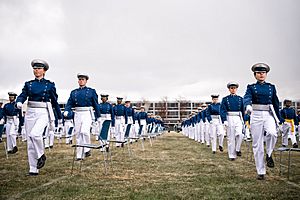
A very important event was when women were allowed to join. On October 7, 1975, President Gerald R. Ford signed a law allowing women into U.S. service academies. On June 28, 1976, 157 women entered the Air Force Academy with the Class of 1980.
Since there were no older female cadets, fifteen young female officers helped with the integration. The female cadets were first kept separate but later joined their assigned squadrons. On May 28, 1980, 97 of these original female cadets graduated. This was just over 10% of that graduating class. In recent years, women have made up over 20% of the classes. The class of 2016 had the highest number, at 25%.
Many of these early female graduates became very successful. However, women have had higher dropout rates than men. They have also left the Air Force in higher numbers than men.
Recent Academy History
Because of the COVID-19 pandemic, the Class of 2020 graduated six weeks early. This was the first time a USAFA class graduated early. It was also the first time for any military academy since the Vietnam War. This class was also the first to have officers join the U.S. Space Force. General Jay Raymond gave the oath of office to 86 graduates.
The U.S. Space Force created its first unit at the academy in November 2021. It is expected that about 10% of academy graduates will join the Space Force.
Campus and Buildings

The academy's campus covers about 18,455 acres. It is on the east side of the Rampart Range of the Rocky Mountains, north of Colorado Springs. The cadet area is about 7,258 feet above sea level. The famous architecture firm Skidmore, Owings and Merrill (SOM) designed the academy.
The most talked-about part of the design was the chapel. It was designed by Walter Netsch. Its unique, accordion-like shape is now a famous symbol of the academy.
The Cadet Area
The buildings in the Cadet Area have a modern style. They use a lot of aluminum on the outside, which looks like aircraft or spacecraft. On April 1, 2004, the Cadet Area was named a National Historic Landmark. This was 50 years after Congress approved building the academy.
The main buildings are around a large square called the "Terrazzo." The most famous building is the Cadet Chapel with its 17 spires. Other buildings on the Terrazzo include Vandenberg Hall and Sijan Hall, which are dormitories. Mitchell Hall is where cadets eat. Fairchild Hall is the main academic building. It has classrooms, labs, research areas, and the Robert F. McDermott Library.
The Aeronautics Research Center has many research facilities. These include wind tunnels and engine test cells. Gregory Hall, built in 1997, has chemistry and biology labs. The Cadet Area also has an observatory for studying astronomy. A planetarium, once used for navigation training, reopened in 2019 for learning and entertainment.
Arnold Hall is the cadet social center. It has a theater, ballroom, and dining areas. Harmon Hall is the main administration building. It holds the offices of the academy's leader, the Superintendent.
The Cadet Area also has many sports facilities. These include outdoor athletic fields, the Cadet Gymnasium, and the Cadet Fieldhouse. The Fieldhouse has Clune Arena, an ice hockey rink, and an indoor track. Falcon Stadium, outside the Cadet Area, is the football field. Graduation ceremonies are also held there.
Special Displays
Many displays around the Cadet Area honor heroes and air power pioneers. They also inspire cadets. The War Memorial is a black marble wall under the flagpole. It lists the names of graduates who died in combat. The Honor Wall has the Cadet Honor Code written on it: "We will not lie, cheat, or steal, nor tolerate among us anyone who does."
The Class Wall under the Cadet Chapel shows the symbols of each graduating class. The symbol of the current senior class is in the middle. The Eagle and Fledglings Statue was a gift to the academy in 1958. It has a quote: "Man's flight through life is sustained by the power of his knowledge."
There are also real air and spacecraft on display. These include an F-4C, F-15A, and YF-16A. There's also a B-52 and a Minuteman III missile.
The "Core Values Ramp" leads down to the parade field. New cadets walk up this ramp when they first arrive. From 1964 to 2004, the words "Bring me men ..." were at the bottom of the ramp. These words were from a poem. In 2004, these words were replaced with the academy's core values: "Integrity first, service before self, and excellence in all we do."
Schools for Children
The academy is part of Academy School District 20. Children living on base attend Douglass Valley Elementary, Eagle View Middle School, and Air Academy High School.
Air Academy High School has over 1300 students. It is the only high school built on a military academy in the U.S. It is one of the top ten high schools in Colorado for academics. Its marching band often places high in state championships. The school district also has an elementary school on the academy grounds.
Other Campus Locations
Other places on campus help with cadet training and base operations. Doolittle Hall is the main office for the Association of Graduates. It is also where new cadets first arrive for Basic Cadet Training. It is named after General Jimmy Doolittle.
The Goldwater Visitor Center is for families, friends, and tourists. It is named after Senator Barry Goldwater, who supported the academy for a long time. The Academy Airfield is used for training cadets in flying. This includes parachute training, soaring, and powered flight.
The Academy Cemetery is where academy cadets, graduates, and certain officers are buried. Famous air power leaders like Carl Spaatz and Curtis E. LeMay are buried here.
The United States Air Force Academy Preparatory School (Prep School) is a program for students who need extra help to get into the academy. It offers strong academic, athletic, and military training. Many "Preppies" earn a spot at the academy after their year at the Prep School.
Honor Code and Character Training
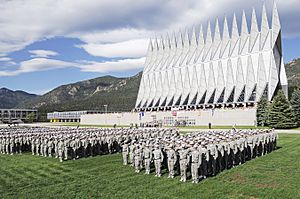
The Cadet Honor Code is a very important part of a cadet's training. It sets the basic rules for how cadets should act. The Class of 1959, the first graduating class, created this code. Every class since then has followed it. The Code is simple:
We will not lie, steal, or cheat, nor tolerate among us anyone who does.
In 1984, cadets voted to add an "Honor Oath." All cadets take this oath. New cadets (freshmen) take it when they are officially accepted into the Cadet Wing. The oath includes the code and a promise to live honorably. Cadets are expected to protect and uphold the code.
Cadet honor representatives teach classes about the code. They also investigate if someone might have broken the code. Cadets serve on "Honor Boards" to decide if a fellow cadet violated the code. If a cadet breaks the code, they might be removed from the academy. Sometimes, they might be put on "honor probation" for a while. This usually happens only for cadets in their first two years.
To help future officers be good leaders, cadets also get character and leadership training. The Center for Character and Leadership Development offers classes and programs. These programs, along with the Honor Code, help the academy create "leaders of character."
How the Academy is Organized
The academy is organized in a special way. It is a military unit, so some parts are like any other Air Force Base. This is true for units that provide services like security and communications. But because it is also a university, the faculty and cadets are organized like a civilian college.
The Cadet Wing
The students at the academy are called the Cadet Wing. They are divided into four classes, like a regular college. But they are called fourth-, third-, second-, and first-class cadets. Fourth-class cadets (freshmen) are often called "doolies." This word means "servant."
First-class cadets (seniors) are called "firsties." They hold leadership roles as cadet officers. Second-class cadets are cadet non-commissioned officers. Third-class cadets are junior non-commissioned officers.
The Cadet Wing is split into four groups. Each group has ten cadet squadrons. Each squadron has about 110 cadets from all four classes. Cadets live, march, and eat meals with their squadrons. Military training and sports are also done by squadron.
Each cadet squadron and group has an active-duty officer called an Air Officer Commanding (AOC). These officers lead the cadets and help them with their military careers. They also serve as role models. Each squadron and group also has an active-duty non-commissioned officer called an Academy Military Trainer (AMT).
Base Organization
The superintendent of the United States Air Force Academy is the top commander. This position is usually held by a lieutenant general. The superintendent is like the president of a civilian university. They oversee all parts of the academy, including training, academics, and admissions. The superintendent reports directly to the Chief of Staff of the Air Force.
People who report to the superintendent include the dean of the faculty and the commandant of cadets. These are usually major generals or brigadier generals. The commander of the 10th Air Base Wing also reports to the superintendent. This wing provides all the support services for the base. The Prep School commander also reports to the superintendent.
Military Training
Cadets receive military training throughout their time at the academy. This training is most intense during their four summers. The first military experience is Basic Cadet Training (BCT). This is a six-week program in the summer before their freshman year. During BCT, also called "beast," new cadets learn military basics. They learn from older cadets. They learn military customs, how to wear uniforms, and how to march. They also study military knowledge and do tough physical training.
In the second half of BCT, cadets march to Jacks Valley. There, they complete the program in a field camp. After BCT, new cadets get their shoulder boards. They take the Honor Oath and are officially part of the Cadet Wing.
The freshman year is usually the hardest for cadets. They have a full academic schedule and many military demands. They must learn a lot of military and academy information. They also have strict rules about where they can go and how they act. The freshman year ends with "Recognition." This is a tough event that lasts several days. It ends with cadets getting the Prop and Wings insignia. This shows they are now upper-class cadets. After Recognition, the strict rules are relaxed.
After their first year, cadets have more choices for summer training. Between their freshman and sophomore years, they train in teamwork during Adventure Based Learning (ABL). They can also fly gliders, train in cyber-warfare, or do free-fall parachute training. In their last two summers, cadets can train new cadets. They can also visit Air Force bases and join other leadership programs. They might also take courses from other military services. During the school year, all cadets take classes in military theory, operations, and leadership.
Academics
The Air Force Academy is a four-year university. It offers bachelor's degrees in many subjects. About 70% of the teachers are active-duty Air Force and Space Force officers. The rest are civilian professors or visiting professors.
All graduates receive a Bachelor of Science degree. This is because of the many technical courses they take. Cadets can choose from various majors. These include engineering, science, social sciences, and humanities. The academic program has a core curriculum. All cadets take required courses in science, engineering, social sciences, humanities, military studies, and physical education. About 60% of a cadet's courses are required. So, most of their first two years are spent on core classes. In their third and fourth years, cadets can focus more on their major. They can also join exchange programs with other military academies or countries.
Historically, the academy focused on science and engineering. This was because many graduates would manage complex air and space systems. So, the academy's engineering programs have always been highly rated. But over time, the academy added more humanities courses. About 47% of cadets now choose non-technical majors. Recently, the academy started a computer and network security program.
Research funded by outside groups has grown a lot in the technical majors. The Air Force Academy has ranked highest among undergraduate-only universities for federally funded research. Many cadets do research as part of their major. This research happens in over a dozen academy research centers.
Cyber Competition Team
The Air Force Academy has a Cyber Competition team. This team is part of the Department of Computer and Cyber Science.
In November 2017, academy teams won first and second place. They competed against the U.S. Military Academy, U.S. Naval Academy, and U.S. Coast Guard Academy. This was at the CyberStakes Live competition in Las Vegas.
In March 2019, the team won the Atlantic Council's national Cyber 9/12 Strategy Challenge. In April 2019, the National Security Agency announced that the U.S. Air Force Academy won the 2019 NSA Cyber Exercise. This event included forensics, cyber policy, and a cyber combat scenario.
In 2018, the USAFA Class of 1968 decided to support the Cyber Team. They aimed to raise over $500,000 to help with travel and other costs.
Athletics
All cadets must take part in the academy's large athletic program. This program helps cadets get physically fit. It also helps them develop skills for being officers. It teaches leadership and builds character. The main parts of the program are intercollegiate sports, intramural sports, physical education, and physical fitness tests.
Physical Education Classes
Cadets must take physical education courses every year. All freshmen must take Boxing and Physical Development. Sophomores take Swimming and Water Survival. They also choose an individual sport like tennis or golf. Juniors take Combatives (unarmed combat) and a team sport like volleyball or basketball. Seniors choose two elective courses. Cadets in intercollegiate sports usually have a different schedule for their PE courses.
Physical Fitness Tests
Every semester, cadets must pass two fitness tests. One is a 1.5-mile run to check their aerobic fitness. The other is a 15-minute test with five events. These events are pull-ups, a standing long jump, sit-ups, push-ups, and a 600-yard sprint. If a cadet fails a test, they usually go to a special reconditioning course. If they keep failing, they might be removed from the academy.
Intramural Sports
All cadets must play intramural sports. This is unless they are playing an intercollegiate sport. Intramural sports have cadet squadrons compete against each other. Sports include basketball, cross-country, flag football, ice hockey, racquetball, flickerball, rugby union, boxing, soccer, mountain biking, softball, team handball, tennis, Ultimate, wallyball, and volleyball. Winning the Wing Championship in a sport is a big source of pride for a squadron.
Intercollegiate Sports

The academy has 27 NCAA-sanctioned teams. They are called the Falcons. Men's teams include football, baseball, basketball, and ice hockey. Women's teams include basketball, cross-country, and gymnastics. The academy also has a coeducational rifle team. There are also club sports like rugby.
Most teams compete in the Mountain West Conference. However, the wrestling team is in the Big 12 Conference. The men's soccer team is in the Western Athletic Conference. The men's hockey team is in Atlantic Hockey America. The men's lacrosse team is in the Atlantic Sun Conference. The men's boxing team competes in the National Collegiate Boxing Association.
Air Force has rivalries with Navy and Army. The three academies compete for the Commander-in-Chief's Trophy in football each year. Air Force has won this trophy 18 times out of 34 years. The academy also has a rivalry with Colorado State Rams football.
The boxing team has won 18 national championships. The academy's men's and women's rugby teams have won many national championships. The football team has played in 17 bowl games. The men's ice hockey team made it to the NCAA hockey tournament in 2007 and 2008. In 2007, they made it to the "Elite Eight" of hockey, which was their farthest ever.
The track and field team has also had national and international success. Three women won Division II NCAA titles. Three athletes have won Division I NCAA outdoor titles. Alonzo Babers, a 1983 graduate, won gold medals in the 400 meters and the 4x400 meter relay at the 1984 Los Angeles Olympic Games.
Airmanship
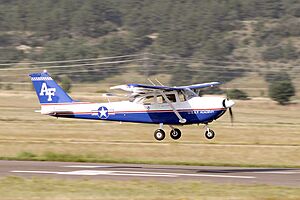
Cadets can take part in several flying activities. These include soaring, parachuting, and powered flight. The 306th Flying Training Group runs these activities.
The 94th Flying Training Squadron teaches cadets basic flying skills using TG-16A gliders. Some soaring students become instructor pilots. They teach new classes and compete on the Soaring Racing Team.
Cadets can also take a parachuting course. The 98th Flying Training Squadron runs this course. Hundreds of cadets earn their Basic Parachutist Badge by completing five jumps. Some cadets get more training and join The Wings of Blue, the U.S. Air Force Parachute Team.
A powered flight program teaches cadets the basics of flying powered aircraft. The 557th Flying Training Squadron uses T-53A aircraft for this. Cadets can even fly solo. The U.S. Air Force Academy Flying Team has about 26 cadets. They compete in national flying competitions using T-41D and T-51A aircraft.
Admissions
| Race and ethnicity | Total | ||
|---|---|---|---|
| White | 63% |
|
|
| Hispanic | 12% |
|
|
| Other | 9% |
|
|
| Asian | 7% |
|
|
| Black | 6% |
|
|
| Foreign national | 1% |
|
|
| Economic diversity | |||
| Data Not Available | |||
To be able to join the academy, a candidate must:
- Be a U.S. citizen (unless nominated by another country's defense department).
- Be unmarried and have no dependents.
- Have good moral character.
- Be at least 17, but less than 23 years old by July 1 of the entry year.
- Meet high standards for leadership, academics, physical fitness, and health.
Besides the regular application, all candidates need a nomination. This usually comes from a U.S. Senator or U.S. Representative. Each member of Congress and the vice president can have five students at the academy at one time. Getting a nomination is not political. You do not need to know your senator or representative.
There are also nomination spots for children of career military personnel. This includes children of disabled veterans or veterans who died in action. Children of Medal of Honor recipients can also get nominations. The application process is long. Applicants usually start in their junior year of high school.
Class Size Over Time
The first class in 1959 had 306 cadets. By 1961, it was down to 271. But because more officers were needed during the Vietnam War, the class size grew. In 1970, there were 745 new cadets. It peaked in 1974 with 1,620, and in 1975 with 1,626. After that, class sizes went down to about 1,300. From 1995 to 2005, the average class size was about 1,250 freshmen. In 2012, the entering class was about 1,050. The class of 2022 started with 1,286 students. The class of 2023 began with 1,159.
Traditions
Academy Nicknames
Graduates of the academy are often called the Long Blue Line. Cadets and alumni are also known as Zoomies.
Prop and Wings Insignia
The Prop and Wings insignia was used by earlier U.S. Army Air services. It became the symbol for upper-class cadets at the Air Force Academy. This started with the first class in 1959. Freshmen cadets receive this insignia at the Recognition Ceremony. This happens near the end of their first year. The standard insignia is all silver. Cadets whose ancestors served in earlier air forces, or who are direct descendants of academy graduates, can wear a special silver prop and gold wings insignia.
Acceptance Parade and Parents' Weekend
The Acceptance Parade celebrates the end of Basic Cadet Training (BCT) for new freshmen cadets. At this parade, freshmen cadets receive their uniform shoulder boards. This shows they have completed BCT and are now part of the Cadet Wing. They also formally take the USAFA Honor Code Oath. The "Legacy class," which graduated 50 years before, gives a book called Contrails to outstanding cadets.
A few weeks later, during the Labor Day weekend, is Parents' Weekend. This is the first time freshmen cadets can see their families since they arrived. After the Cadet Wing Parade, families can visit the cadet dorms and other buildings.
Class Exemplar
During the fall semester of their sophomore year, cadets choose a class exemplar. This person becomes the namesake for their class. The exemplar is usually a deceased member of the Air Force or earlier air forces. Some exceptions include the Wright Brothers and Neil Armstrong. This tradition started with the Class of 2000. The selection of the class exemplar is celebrated with a special dinner.
Commitment Dinner
Commitment Dinner happens before the start of the sophomore fall semester. By attending this dinner, sophomore cadets formally promise to serve in the Air Force or Space Force after graduation. Before this point, freshmen or sophomore cadets can leave the academy without any financial or military obligations. After Commitment, cadets who leave the academy might have to pay money back or serve active duty in the Air Force or Space Force.
Class Crest
Each class of cadets designs its own class crest. The crest must include the class number, the class year, the Polaris star, and the eagle. These elements are on the Class of 1959's crest. The final crest is shown during the Ring Dance. This is when junior cadets receive their class rings. During the senior year, the crest is displayed on the Crest Wall on the Terrazzo.
Class Ring
The tradition of the class ring started at the U.S. Military Academy in 1835. It then spread to the U.S. Naval Academy. The Air Force Academy continued this tradition with its first class in 1959. So, it is the only service academy that has had class rings for every class since it began.
The Air Force ring is special because it is white gold. Other academies use yellow gold. One side of the ring has the academy crest. The other side has the class crest. The center of the ring says "United States Air Force Academy." Cadets choose their own stones for the center.
Cadets receive their rings during their junior year at the Ring Dance. This happens at the start of graduation week for the class ahead of them. Traditionally, the rings are placed in champagne glasses. Cadets catch them with their teeth after a toast. During the senior year, the ring is worn with the class crest facing the wearer. After graduation, the ring is turned so the class crest faces out.
100's Night
100's Night happens 100 nights before senior cadets ("firsties") are set to graduate. It is a formal dinner to celebrate all they have achieved. It also celebrates their upcoming commissioning as Second Lieutenants. After dinner, seniors get a weekend off to celebrate. While they are gone, freshmen cadets decorate their rooms to celebrate.
Music at the Academy
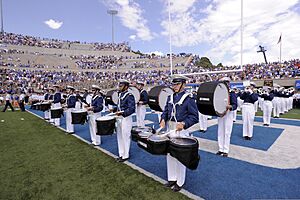
The United States Air Force Academy Band provides music for ceremonies and events. It is made up of full-time musicians, not cadets. The United States Air Force Academy Drum and Bugle Corps is made up of cadets. It performs at academy events like football and basketball games.
The two bands wear different uniforms. The academy band wears a special full dress uniform. The drum and bugle corps wears standard cadet uniforms.
Notable Alumni
See also
 In Spanish: Academia de la Fuerza Aérea de los Estados Unidos para niños
In Spanish: Academia de la Fuerza Aérea de los Estados Unidos para niños
- United States service academies
- United States Air Force Academy (USAFA)
- United States Coast Guard Academy (USCGA)
- United States Merchant Marine Academy (USMMA)
- United States Military Academy (USMA; Army)
- United States Naval Academy (USNA)
- List of colleges and universities in Colorado
- Air Force Academy, Colorado
- Jabara Award
- KAFA-FM radio
Images for kids




